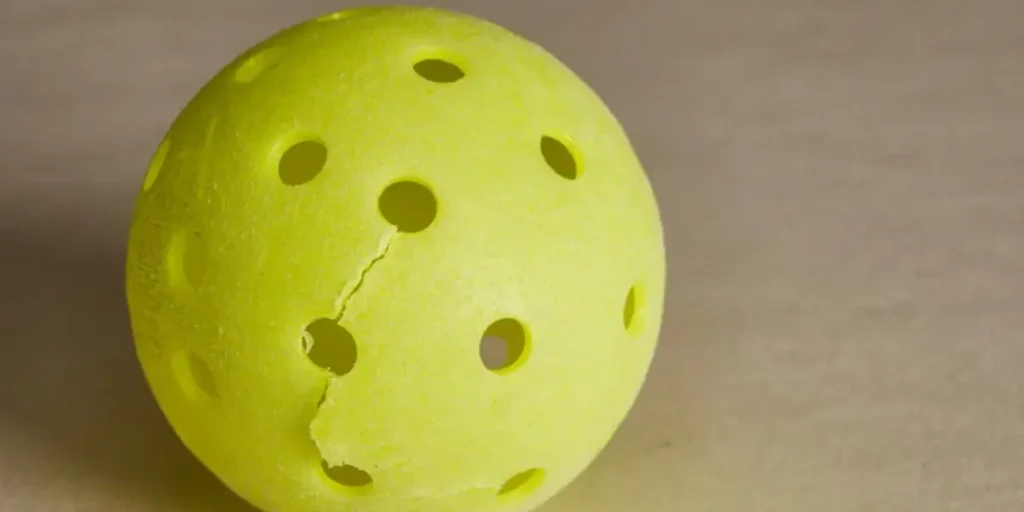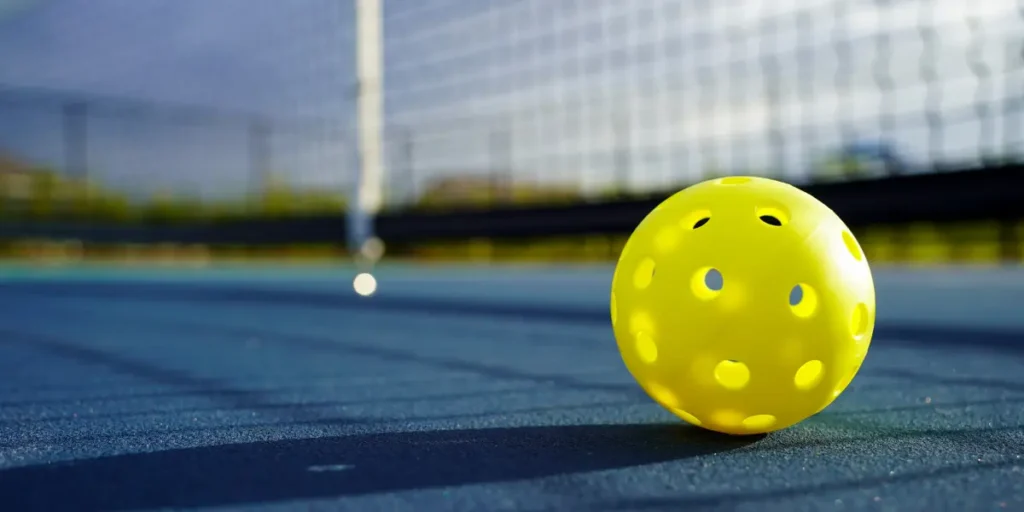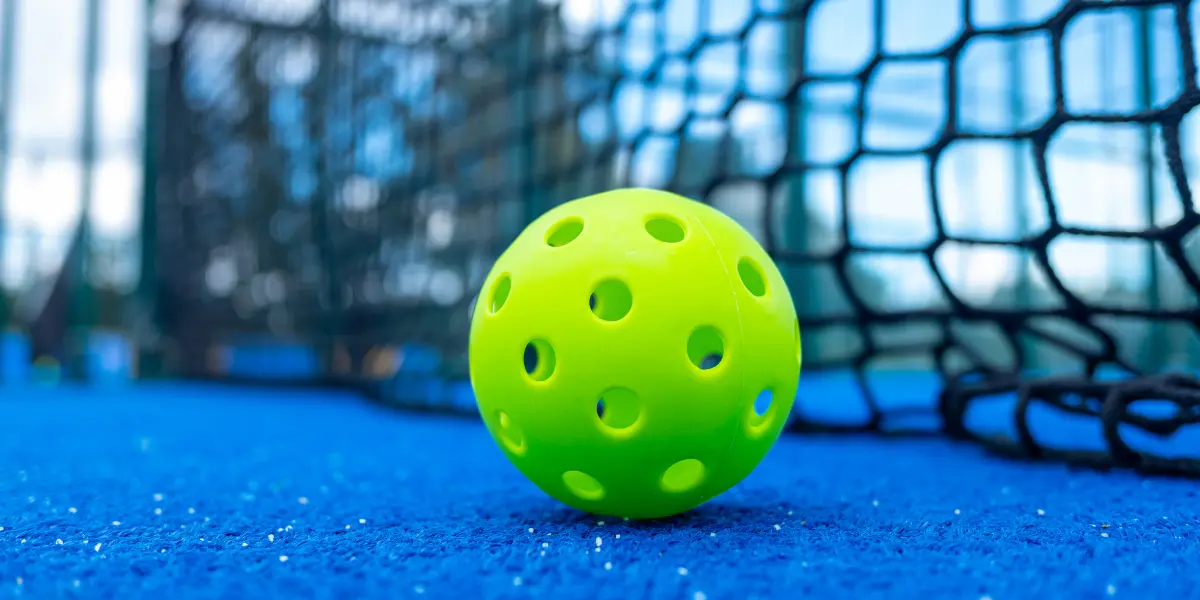Nothing’s more frustrating than mid-game disruptions caused by worn-out pickleballs. Whether you’re playing casually or training seriously, the condition of your balls directly impacts how the game feels, bounce, flight, even sound.
Some balls last just a few games, while others hold up for weeks. But what really determines that lifespan? It isn’t just about brand or price, it’s about how, where, and how often you play.
In this guide, you’ll learn exactly what shortens a pickleball’s life, how to spot signs of wear early, and which types or brands tend to last longer under different conditions.
Average Lifespan of a Pickleball Ball
The average pickleball typically lasts between 3 to 10 games, depending on how and where it’s used. On average, you can expect a lifespan of about 10 to 15 hours of play.
Players who use more spin, power, or play frequently on abrasive outdoor courts may need to replace their balls more often, sometimes after just a few games. On the other hand, those playing indoors or using a softer touch may get more life out of each ball.
Lifespan of Indoor vs Outdoor Balls
Indoor pickleballs are made from softer plastic and are designed for smoother surfaces like gym floors. Because they aren’t exposed to harsh conditions, they tend to last longer, usually around 15 to 25 games or 10 to 15 hours of play. These balls also maintain their bounce and shape better over time unless exposed to extreme temperatures.
Outdoor balls, however, face much tougher conditions. They’re made from harder plastic to resist wind and rough surfaces like concrete or asphalt, but even so, they tend to wear out faster. Most outdoor pickleballs last about 3 to 10 games or 2 to 6 hours of play. Weather can also be a big factor, cold temperatures often make these balls brittle and prone to cracking.
- Check out: Difference between Indoor vs Outdoor Balls.
Lifespan by Balls Brand
Some brands are known for better durability than others. Dura Fast 40 balls, for example, are popular in tournament play due to their speed and bounce, but they tend to crack after just a few games especially in colder weather.
Franklin X-40 balls strike a nice balance between performance and durability. Many players report getting around 6 to 10 games from them before seeing any signs of wear.
Onix Fuse indoor balls are known for holding up well across 15 or more games, while their outdoor version performs better than many budget balls, though still not immune to cracking on hard courts.
Signs Your Pickleball Needs to Be Replaced
Even if there’s no visible damage, a change in sound, like a duller pop, can signal it’s time for a new ball. Keeping an eye out for these signs helps maintain the quality of your game.

You might also notice the ball wobbling mid-air, which can affect your shots and spin control. Cracks, chips, or small dents are obvious indicators that the ball is no longer in good condition. Outdoor balls especially tend to crack near the seam after repeated use.
Knowing when to replace your pickleball is essential for consistent performance during play. One of the first signs is a change in the ball’s bounce. If it feels soft or doesn’t bounce as high as it used to, it’s likely worn out.
Tips to Make Pickleballs Last Longer
If you want to extend the life of your pickleballs, a few small habits can make a big difference. First, always store your balls in a cool, dry place, extreme heat or cold can cause the plastic to warp or crack faster. Leaving them in a hot car or freezing garage? Not a good idea.
Rotating your pickleballs is another simple trick. Use different balls for practice sessions and save the newer ones for matches. This helps evenly distribute wear and tear.
Also, give them a quick wipe every now and then. Dirt and grit from courts can build up on the surface, causing them to bounce unevenly or wear out faster. A damp cloth is all you need to keep them clean and game-ready.
These small steps can stretch the lifespan of your pickleballs, saving you money and improving your overall playing experience.
Best Long-Lasting Pickleballs (By Brand)
Not all pickleballs are built the same, some are known to last longer and perform better over time. Based on consistent player feedback and durability tests, a few brands stand out.
Franklin X-40 is a popular choice for both casual and tournament play. It offers a good balance of performance and longevity, especially on outdoor courts. The ball holds its shape well and resists cracking longer than many lower-end options.
Dura Fast 40 is widely used in professional settings and has a reputation for top-tier performance. While it may not last quite as long as some others due to its hard plastic, it provides consistent bounce and feel, which makes it worth the investment for serious players.
Onix Fuse is often preferred for indoor play. It tends to hold up better on gym floors, with fewer cracks or soft spots after extended use.
If you’re looking for budget-friendly options, brands like Tourna and Core offer decent durability at a lower price. However, if you play frequently or at a competitive level, investing in premium balls often pays off in the long run.
- Check out: What type of balls Is Used in Pickleball.
When to Replace Pickleballs for Tournaments
In tournament settings, the condition of a pickleball isn’t just a matter of personal preference, it directly affects gameplay quality, fairness, and consistency. Most tournaments, especially those sanctioned by USA Pickleball (USAPA), require balls to meet specific standards in terms of bounce, roundness, and integrity.

A ball that’s cracked, warped, or overly soft won’t perform consistently, which can lead to unfair advantages or unpredictable rallies. That’s why players and officials typically replace balls much sooner in competitive settings compared to casual play.
If you’re preparing for a tournament, it’s a smart idea to use a fresh or lightly used ball for each match. Some serious players even rotate balls during practice so that their match-day equipment feels familiar yet reliable.
While tournament organizers often provide balls, bringing a few new ones from a preferred brand ensures consistency and peace of mind.
Factors That Affect Pickleball Lifespan
Several factors influence how long a pickleball will last. First, the playing surface plays a major role, rough outdoor courts like concrete or asphalt wear down balls much faster than smooth indoor floors.
Second, temperature matters; cold weather can make balls more brittle, leading to quicker cracks or breakage. Third, your style of play impacts durability. Hard hitters or players who use a lot of spin typically wear out balls faster than casual players.
Lastly, ball quality and brand also matter. Higher-quality balls from trusted brands tend to last longer than cheap, low-grade options. Storing your balls in a cool, dry place away from direct sunlight can also help extend their life.
FAQs
Technically yes, but it’s not recommended. A cracked ball can bounce unpredictably, affect accuracy, and make rallies less enjoyable. For casual backyard games, it might be acceptable, but for consistency, it’s better to replace it.
Outdoor balls are exposed to rough courts, sunlight, and temperature swings, which cause them to wear and crack more quickly. Indoor balls face smoother surfaces and gentler play, so they typically last longer.
Often, yes. Premium balls are usually better balanced, more durable, and consistent in bounce. They might cost more upfront, but their longer life and performance can save money in the long run.
Conclusion
The lifespan of a pickleball depends on several factors, including how often you play, whether you’re playing indoors or outdoors, and how well you take care of your gear.
While even the best pickleballs won’t last forever, small habits like rotating your balls between practice and matches, storing them properly, and choosing the right brand for your playing conditions can go a long way in getting the most out of each one.
By paying attention to signs of wear and replacing balls at the right time, especially for tournament play, you’ll ensure better performance, consistency, and overall enjoyment on the court.

